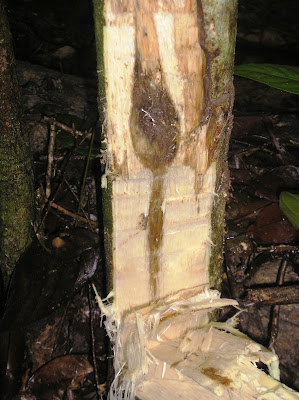Salam sejahtera,
Hari Khamis yang lalu yang telah berkesempatan pulang ke kampung di Kg Lepar, Pahang. Petang itu, saya telah diperkenalkan oleh pakcik saya dengan seorang penggiat tani di kampung berhampiran. Apa yang menariknya ialah beliau ini bukan sahaja melakukan aktiviti bertani tetapi juga mengusahakan pengeluaran sejenis Cecair Kawalan Serangga berasaskan herba 100%. Cecair ini mampu mencegah pelbagai jenis serangga dari jenis ulat bulu, teritip, kutu mahupun lintah atau kumbang.
Memandangkan kesuntukan waktu, pertemuan dan perbincangan dengan beliau telah diteruskan keesokan harinya. Saya telah mengambil kesempatan pagi Jumaat itu untuk menunjukkan kepada beliau gambar-gambar ulat yang telah menyerang tanaman karas di Hulu Langat. Menurut beliau, ulat-ulat tersebut adalah dari jenis 'armyworm' dan beliau juga mengesahkan bahawa Cecair Kawalan Serangga keluaran beliau mampu untuk menghapuskan ulat-ulat tersebut. Di samping berkemampuan untuk menghapuskan ulat-ulat dan serangga, cecair tersebut juga dapat bertindak sebagai baja organik kerana ia diperbuat daripada 100% herba.
Di samping itu, ia juga tidak membahayakan kesihatan. Tanaman sayuran yang disembur Cecair Kawalan Serangga ini boleh dipetik dan dimakan serta-merta tanpa sebarang tindakbalas sampingan.
Berikut adalah fakta berkenaan 'armyworm' dipetik dari portal
OISAT untuk rujukan ramai:
Source: University of Nebraska-Lincoln
General Information
Common name: Armyworm
Lepidoptera:Noctuidae
Host plants
Armyworm larva feeds on almost all agricultural crops.
Distribution
India, Asia, Australia, New Zealand, Canada, and USA
Damage
The larvae can eat the entire leaves of field crops and grasses. When
feeding, they chew from the leaf edges until only the midrib is left.
They feed on various crops and grasses during their migration, and often
bare crops of tender leaves after passing through. They travel from
field to field in great numbers, hence the name "armyworm".
Description
The larvae are described to differentiate the several armyworm species from each other.
- American or Southern armyworm, Fall armyworm, Grass worm, Overflow worm (Spodoptera frugiperda)
Mature larvae measure 3.6-4 cm long. They are gray to black in color
with alternately bright and pale yellow stripes running longitudinally
along their bodies. Black crescent spots are found next to the stripes
(IRRI, 2001).
- African armyworm, Black armyworm (S. exempta)
Mature larvae measure up to 4 cm long and are generally black, heads
faintly mottled with dark brown spots, and with light yellow stripes at
their backs. They are characterized by the presence of C-shaped dark
spots along their backs (IRRI, 2001).
- Grass armyworm, Rice swarming caterpillar (S. mauritia)
Mature larvae are 3.8-4 cm long and have shades of green, gray, or brown
with dark dull dorsal and subdorsal longitudinal stripes. Two rows of
C-shaped black spots are distinct along the backs (Reissig; et. al.,
1986: pp. 99-109).
- Paddy armyworm, Rice armyworm, True armyworm, Rice ear-cutting caterpillar (Mythimna separata)
Mature larvae are 3-4 cm long and are green to pink in color, with
longitudinal light grey to black stripes running along the entire length
of their bodies. They have brown to orange heads with an A-marking
(Reissig; et. al., 1986: p. 102).
- Yellow striped armyworm (Spodoptera praefica)
Mature larvae are about 4 cm long and black in color with yellow or
orange stripes along their sides. These are bordered below by a
white-stripe on each side. They have an inverted-white-Y on the front of
the heads (IRRI, 2001).
- Armyworm (Pseudaletia unipuncta)
The full grown larva is 3-4 cm long with two orange stripes on each
side. Above and below the spiracles, there is a pale-orange and
white-bordered stripe. Less distinctive brown stripes are found on the
body (CABI, 2000).
- Beet army worm (S. exigua).
The larvae are 3-4 cm long, green in color with many light stripes along
the backs and a broader stripe down the sides. The undersides are
usually yellow color (Ellis; Bradley, 1996: pp. 270-271.10).
Morphology
Eggs of armyworms are white and are found in clusters. One egg mass
contains 200-300 eggs. These turn yellowish when mature. Hatching occurs
in about 2-5 days.
The larva varies its colors according to the species. Sizes vary from
2-4.5 cm long. The larva has 6 small legs just behind the head and 10
fleshy legs at the rear. The larva eats voraciously as it grows. It digs
3-6 cm below the soil surface to pupate.
The pupa is brownish red in color and about 2-3 cm long. Pupation takes about 7-16 days depending on the climatic conditions.
The moth has 3-4 cm wingspan and 1.5 cm long. Colors vary from light
green, light pink, tan, to dark brown in color. The tiny white dot in
the center of each forewing is an important feature to identify the
armyworm moth. The moth is seldom seen because it is active only at
night time, either mating or searching for suitable egg-laying sites.
The female moths lay eggs on the lower leaves of growing grasses or
small grains.










